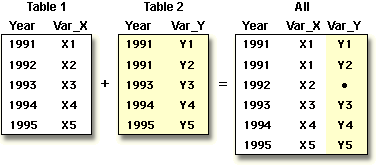| Merging SAS Data Sets |
| Lesson
Overview |
| Introduction
In SAS programming, a common task is to combine observations from two or more data sets into a single observation in a new data set according to the values of a common variable. In DATA step terminology, this is called match-merging. |

In match-merging, often one data set contains unique values
for the common variable (YEAR, Table 1 above), and other data
sets contain multiple values for the common variable (YEAR,
Table 2 above).
This lesson shows you how to match-merge any number of SAS data sets using the DATA step. When you use the DATA step to perform a match-merge, you have a high degree of control in creating and manipulating data sets. This lesson contains 44 pages and takes approximately 60-90 minutes to complete.
|
| Objectives
In this lesson, you learn to
Before taking this lesson, you should have completed the following lessons: Introduction to SAS Programming |
  |
|
Copyright © 2002 SAS Institute Inc.,
Cary, NC, USA. All rights reserved.